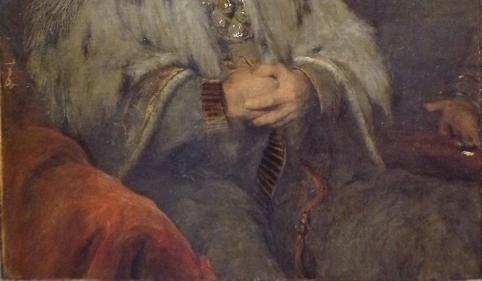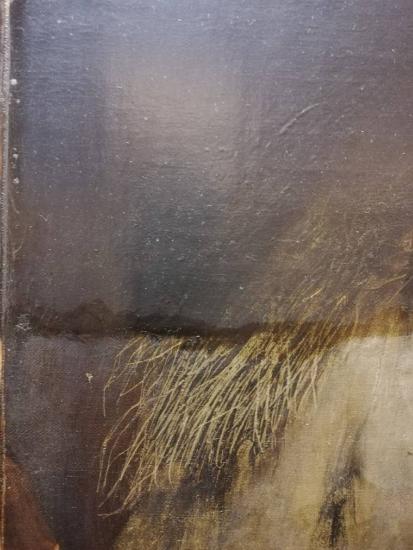The Mystery of the Floating Hand
Posted on: 21 August 2020 by Amanda Draper Curator of Art and Exhibitions in 2020
.jpg)
Amanda Draper, Curator of Art & Exhibition writes …
As a curator who looks after art collections, one of my favourite things is working with the specialist conservators who restore and revive artefacts for us. Their technical and artistic skills are phenomenal and they can completely transform an artwork that most of us would have thought beyond repair. And just sometimes, simply cleaning a painting can reveal unexpected wonders. And so it was with The Turkish Ambassador.
Turkish Ambassador before conservation
The Turkish Ambassador, c.1690
Attributed to Aert de Gelder (1645 – 1727)
(Oil on canvas)
The Turkish Ambassador
To be completely honest, we are not sure if this sitter in his magnificently sumptuous clothes is supposed to be an Ambassador or if he is even Turkish. His outfit resembles those of senior leaders of the Ottoman Empire but it is an imagined scene: the sitter is a model dressed in clothes chosen by the artist and posed in a certain attitude. It is not a portrait of a real person. The painting is attributed to Aert de Gelder, which means that is has all the hallmarks of the artist but we’ve no absolute proof at the moment it is really by him. The more we can learn about the painting, the closer we get to the proof.
Aert de Gelder
Aert de Gelder is an important artist because of his own talent, but also because he was the last student of one of the greatest names in painting: Rembrandt. De Gelder was born in Dordrecht in Holland and studied with Rembrandt in Amsterdam between 1661 and 1663. De Gelder adopted many of the techniques and warm tonal palette of his master but with lighter hues. He favoured Biblical scenes from the Old Testament which often featured characters dressed in Middle-Eastern style costume. Art commentators praise de Gelder for the realistic interaction of his characters through their facial expressions and hand gestures. Yes, we are getting closer to the mysterious hand …
The hand makes an appearance
We see that our Turkish Ambassador sits calmly with his hands clasped in front of him and a thoughtful expression on his face. What is he thinking about? The question was partially answered when the painting was taken to paintings conservator Vanessa Andrew for cleaning and general tidying up. Vanessa expertly wiped away centuries of surface dirt, and beneath that discoloured varnish, and beneath that paint which had been laid over the original painting. Beneath the overpainting a disembodied hand appeared to the right of the Ambassador. No figure attached to it, just a gesticulating hand! So there had originally been at least one other figure in the painting but, at some point in its 330-year history, it had been cut down so that just the Ambassador remained. Why? We may never know. But it is likely that original painting was on a theme of some kind, perhaps Biblical, and one of its many owners through its history didn’t like it but thought the Ambassador was worth keeping. The gesticulating hand indicates that the other figure was speaking to the Ambassador in an animated fashion. This would explain his thoughtful expression, at least. It just raises a lot more questions, as so often happens with historic paintings.

Mystery hand appears on right

Detail of fur revealed by cleaning
The Turkish Ambassador’s Provenance
The Turkish Ambassador was bequeathed in 2000 by Mrs Betty Horsfall, a generous benefactress to the University of Liverpool. A keen botanist, she became involved with the University through its Ness Botanic Gardens. The painting used to hang in Mrs Horsfall’s Gloucestershire home and is thought to be from a collection she inherited from her father, Captain Frank Rushby, after he died in battle during World War 1. Capt. Rushby was a keen collector of art and antiques, making most of his acquisitions during the years 1900 – 1910. It is unlikely they ever knew about the Turkish Ambassador’s extra hand, or that their painting should have been much larger.
.jpg,USE-539x722.jpg)
Turkish Ambassador after conservation
The hand disappears again
When conservator Vanessa contacted me about her bizarre discovery of the hand it set up a discussion about what was best to do: keep it as it was or cover up the hand again. We decided to document the hand, then have Vanessa carefully paint over it again. Her overpainting can always be reversed because the hand isn’t really going anywhere. Plus, the way the painting is currently presented as a sole portrait of the Turkish Ambassador is the way that the person who made the alteration intended it to look. It is part of the painting’s long history.
Keywords: Turkish Ambassador, Aert de Gelder, Rembrandt, Painting conservation.
.jpg,USE-541x701.jpg)